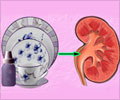Researchers have found obese children suffering from nonalcoholic fatty liver disease (NAFLD) are at an increased risk of suffering from high blood pressure.

NAFLD - the inappropriate storage of fat droplets inside liver cells - is the most common cause of chronic liver disease in the United States and affects nearly 10 percent of all children. Although children with chronic liver disease often have no symptoms, some children with NAFLD will have fatigue and/or abdominal pain. The initial evaluation for NAFLD is via a blood test and diagnosis is ultimately based upon a liver biopsy. The disease is most common in children and teenagers who are overweight and can develop in conjunction with other health problems, such as diabetes.
The study, conducted by the National Institutes of Health Nonalcoholic Steatohepatitis Clinical Research Network, enrolled 484 children with NAFLD between two-and-17-years-old. The participants'' blood pressure was assessed at enrollment and at 48 weeks. Nearly 36 percent of the group had high blood pressure at baseline; 21 percent had persistent high blood pressure almost a year later. In comparison, high blood pressure was present in two to five percent of all children and 10 percent of obese children.
"Along with being at an increased risk for cardiovascular disease, we found that children with NAFLD who had high blood pressure were significantly more likely to have more fat in their liver than children without high blood pressure. This could lead to a more serious form of liver disease," said Schwimmer.
Researchers also found that compared to boys, girls with NAFLD were significantly more likely to have persistent high blood pressure.
Currently, there are no approved and effective treatments for children with NAFLD. However, there are treatments for high blood pressure.
Advertisement
Co-authors include Anne Zepeda and Kimberly P. Newton, UC San Diego; Cynthia Behling, Sharp Medical Center; Erin K. Hallinan, Michele Donithan and James Tonascia, Johns Hopkins Bloomberg School of Public Health; and Stavra A. Xanthakos, Cincinnati Children''s Hospital Medical Center.
Advertisement
Source-Newswise














